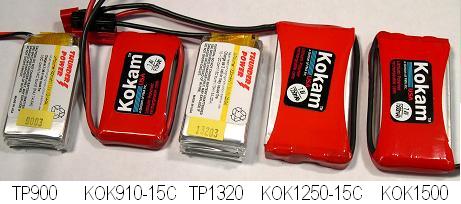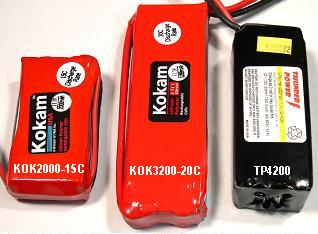

|
Packs for Planes larger than Parkfliers
LiPo cells have been popular with indoor and park flyers for some time now. The early cells were limited in the amount of current they could supply without premature cell failure. This worked well with the small motors that required only a few amps. Flyers benefited from lighter weight and longer flight times. Higher current draws necessitated paralleling several cells to achieve the desired current and low internal resistance. These packs provided huge capacities, and modest weight reduction. However, they were quite expensive and bulky. There has been steady improvement in current capability and internal resistance. These cells are generally heavier and larger than earlier cells, but the newer cells provide performance improvements that make them suitable beyond park flying. This is not unlike NiCad and NiMH. The most popular cells for our use are heavier and with less capacity than many available cells. The differentiators are lower internal resistance and ability to supply higher currents. These two go hand-in-hand. It is the internal resistance that determines how hot the cells get (I*I*R).
We have tested cells that are suitable for Speed 400 and larger planes. The Thunder Power cells have improved to where a single cell is suitable for brushed and brushless Speed 400 applications, and two paralleled cells now do the job of four previous generation cells. The newest Kokam cells have eliminated the need to parallel cells for applications up to 64 amps continuous! The first group of cells below is quite suitable for Speed 400 use and most brushless applications in this size range. The TP2100 is not pictured, because I only tested the TP4200 (2 TP2100 in parallel).

The chart below is based on 3S (3 cells in series) LiPo packs. The chart also includes a popular NiCad and NiMH to provide a frame of reference. Equivalent 9-cell packs are assumed for these cells. All the LiPo packs have lower internal resistance than the Nickel packs. Any of these LiPo cells would be a good substitute for Speed 400 use. For further information see applications/conversions.
The data shows a definite correlation between weight and current capability. The KOK1500 is an older cell that shows the weight/resistance/current tradeoff. Even this cell shows a clear advantage over the Nickel cells.
The next batch of cells represents the high end of the current capacity range. These should be capable of replacing Nickel cells in most everything except the extreme competition apps. Again, a couple of representative Nickel cells are included for comparison. These cells are all good replacements for Nickel cells, having lower resistance and less weight. There are other brands of cells and other sizes in this category. It's hard to keep up. I personally would stick to proven brands. "Buy cheap, buy twice." I wish I had more data to offer, but these puppies are not cheap! In my opinion, the KOK3200-20C is the best cell available, period. The KOK2000-15C is a good choice for sport flying, with a good balance of current, capacity, and price. The TP2100 is a no-brainer substitute for CP-1700: same internal resistance, more capacity, and way less weight. This cell is for planes propped for less than 30 amps!The picture below shows a KOK2100-20C pack. This pack has excellent performance, but I feel it's caught between a rock and a hard place. The only advantage it has over the KOK2000-15C is the ability to handle 42 versus 30 amps continuous. If you don't need more than 30 amps continuous, the KOK2000-15C is two-thirds the cost. It is significantly smaller and lighter but with essentially the same internal resistance. If you need more than 30 amps continuous, the KOK3200-20C is only 15% more money. This gets you 50% more capacity and lower resistance at a slight increase in weight. The 3200 also has a better form factor for most applications.
